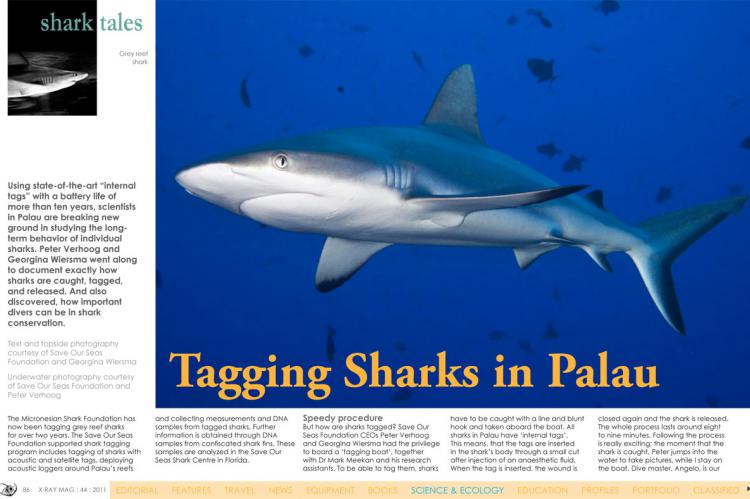Tagging Sharks in Palau
Using state-of-the-art “internal tags” with a battery life of more than ten years, scientists in Palau are breaking new ground in studying the long-term behavior of individual sharks.
Peter Verhoog and Georgina Wiersma went along to document exactly how sharks are caught, tagged, and released. And also discovered, how important divers can be in shark conservation.
Tags & Taxonomy
The Micronesian Shark Foundation has now been tagging grey reef sharks for over two years. The Save Our Seas Foundation supported shark tagging program includes tagging of sharks with acoustic and satellite tags, deploying acoustic loggers around Palau’s reefs and collecting measurements and DNA samples from tagged sharks. Further information is obtained through DNA samples from confiscated shark fins. These samples are analyzed in the Save Our Seas Shark Centre in Florida.
Speedy procedure
But how are sharks tagged? Save Our Seas Foundation CEOs Peter Verhoog and Georgina Wiersma had the privilege to board a ‘tagging boat’, together with Dr Mark Meekan and his research assistants. To be able to tag them, sharks have to be caught with a line and blunt hook and taken aboard the boat.
All sharks in Palau have ‘internal tags’. This means, that the tags are inserted in the shark’s body through a small cut after injection of an anaesthetic fluid. When the tag is inserted, the wound is closed again and the shark is released. The whole process lasts around eight to nine minutes. Following the process is really exciting; the moment that the shark is caught, Peter jumps into the water to take pictures, while I stay on the boat. Dive master, Angelo, is our official shark wrestler; he is the only one able to hold a grey reef shark down.
The shark is obviously not too pleased with our actions, and the only way it can defend itself is of course by biting. The razor-sharp teeth get much too close for comfort. Once Angelo has turned the shark on its back, it calms down.
Keeping the oxygen flowing
Another crew member inserts a tube with running seawater into the sharks mouth, to give it the essential oxygen through its gills. PhD student, Gabriel, makes the cut, and Meekan jots down all the data: size, sex, number of the tag. Nearly all caught sharks are female.
While Peter does the job under the surface, I climb around the boat to document everything topside; I have been warned that I must use every opportunity. There will be no waiting until I have taken my shots. Everyone wants the shark back in the water at high speeds. It’s all like watching a sharky episode of ER, from pulling the shark onto the stretcher until the moment the patient is released into the water again!
The Micronesian Shark Foundation can now use state-of-the-art new tags, with a battery life of over ten years. A big improvement, as the old tags gave up after three years.
The importance of the diving community
Project leader, Tova Harel of Fish ‘n Fins in Palau, started this project a couple of years ago. Her boats go out every day—day after day—under all weather circumstances. Most scientists spend only a couple of weeks ‘in the field’, but the Palauan dive masters are there each and every day. Together with the guests, they fill out forms— how many sharks, depth, water temperature, male or female? The ‘receivers’ on the reefs supply data on the moving patterns of the grey reef sharks. ...
(...)
Download the full article ⬇︎

Originally published
X-Ray Mag #44
Big Mozambique issue: Mega fauna off East Africa with Don Silcock, Tofo and Zavora with Scott Bennett; Diving the islands of the Bahamas with Charles Stirling; Diving diversity on Grand Bahama Island with Matthew Meier; Audace wreck with Massimiliano Canossa; Tagging sharks on Palau with Georgina Wiersma and Peter Verhoog; Deep diving motivation by Wes Skiles; Natural light in underwater photography by Lawson Wood; Nudibranch safari in Norway with Christian Skauge; plus news and discoveries, equipment news, photo and video equipment, dive books, shark tales, whale tales and much more...



